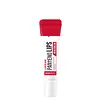What's inside
What's inside
 Key Ingredients
Key Ingredients

No key ingredients
 Benefits
Benefits

 Concerns
Concerns

 Ingredients Side-by-side
Ingredients Side-by-side

Camphor 1%
MaskingMenthol 1%
MaskingPetrolatum 59.14%
EmollientPhenol 0.54%
AntimicrobialBeeswax
Emulsion StabilisingBenzyl Alcohol
PerfumingDiisopropyl Adipate
EmollientAroma
Parfum
MaskingLanolin
EmollientMenthoxypropanediol
MaskingMicrocrystalline Wax
Emulsion StabilisingMyristyl Myristate
EmollientRicinus Communis Seed Oil
MaskingSaccharin
MaskingTheobroma Cacao Seed Butter
EmollientWater
Skin ConditioningPanthenol
Skin ConditioningSorbitol
HumectantIsohexadecane
EmollientCaprylic/Capric Triglyceride
MaskingGlycerin
HumectantDilinoleic Acid/Propanediol Copolymer
EmollientCetearyl Alcohol
EmollientDiisostearyl Malate
EmollientMacadamia Ternifolia Seed Oil
EmollientPEG/PPG-17/6 Copolymer
SolventPhytosteryl Sunflowerseedate
Skin ConditioningBeeswax
Emulsion StabilisingPolysorbate 60
EmulsifyingGlyceryl Stearate
EmollientMethyl Glucose Sesquistearate
EmollientSorbitan Sesquioleate
EmulsifyingHydrogenated Vegetable Glycerides
EmollientDimethicone
Emollient1,2-Hexanediol
Skin ConditioningTocopheryl Acetate
AntioxidantPEG-100 Stearate
Arginine
MaskingCarbomer
Emulsion StabilisingButylene Glycol
HumectantCaprylhydroxamic Acid
Sodium Acrylate/Sodium Acryloyldimethyl Taurate Copolymer
Emulsion StabilisingAllantoin
Skin ConditioningParfum
MaskingPolysorbate 80
EmulsifyingDisodium EDTA
Sodium Hyaluronate
HumectantHelianthus Annuus Seed Oil
EmollientOlea Europaea Fruit Oil
MaskingArgania Spinosa Kernel Oil
EmollientSorbitan Oleate
EmulsifyingWater, Panthenol, Sorbitol, Isohexadecane, Caprylic/Capric Triglyceride, Glycerin, Dilinoleic Acid/Propanediol Copolymer, Cetearyl Alcohol, Diisostearyl Malate, Macadamia Ternifolia Seed Oil, PEG/PPG-17/6 Copolymer, Phytosteryl Sunflowerseedate, Beeswax, Polysorbate 60, Glyceryl Stearate, Methyl Glucose Sesquistearate, Sorbitan Sesquioleate, Hydrogenated Vegetable Glycerides, Dimethicone, 1,2-Hexanediol, Tocopheryl Acetate, PEG-100 Stearate, Arginine, Carbomer, Butylene Glycol, Caprylhydroxamic Acid, Sodium Acrylate/Sodium Acryloyldimethyl Taurate Copolymer, Allantoin, Parfum, Polysorbate 80, Disodium EDTA, Sodium Hyaluronate, Helianthus Annuus Seed Oil, Olea Europaea Fruit Oil, Argania Spinosa Kernel Oil, Sorbitan Oleate
 Reviews
Reviews

Ingredients Explained
These ingredients are found in both products.
Ingredients higher up in an ingredient list are typically present in a larger amount.
Beeswax is natural wax produced by honey bees and can be synthetically created. It consists mainly of fatty acid esters and long-chain alcohols.
In cosmetics, beeswax is a emollient. Due to its waxy structure, it creates a protective barrier. This barrier prevents water from evaporating off the skin.
This may not be a good ingredient for oily skin. We recommend speaking with a professional if you have concerns.
Beeswax cannot be removed with water, but can be taken off with an oil cleanser.
Beeswax is also antiseptic and contains vitamin A.
Learn more about BeeswaxParfum is a catch-all term for an ingredient or more that is used to give a scent to products.
Also called "fragrance", this ingredient can be a blend of hundreds of chemicals or plant oils. This means every product with "fragrance" or "parfum" in the ingredients list is a different mixture.
For instance, Habanolide is a proprietary trade name for a specific aroma chemical. When used as a fragrance ingredient in cosmetics, most aroma chemicals fall under the broad labeling category of “FRAGRANCE” or “PARFUM” according to EU and US regulations.
The term 'parfum' or 'fragrance' is not regulated in many countries. In many cases, it is up to the brand to define this term.
For instance, many brands choose to label themselves as "fragrance-free" because they are not using synthetic fragrances. However, their products may still contain ingredients such as essential oils that are considered a fragrance by INCI standards.
One example is Calendula flower extract. Calendula is an essential oil that still imparts a scent or 'fragrance'.
Depending on the blend, the ingredients in the mixture can cause allergies and sensitivities on the skin. Some ingredients that are known EU allergens include linalool and citronellol.
Parfum can also be used to mask or cover an unpleasant scent.
The bottom line is: not all fragrances/parfum/ingredients are created equally. If you are worried about fragrances, we recommend taking a closer look at an ingredient. And of course, we always recommend speaking with a professional.
Learn more about Parfum